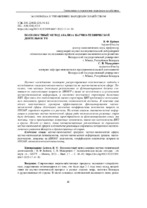Полезностный метод анализа научно-технической деятельности
Another Title
A utility method of scientific and technical activities analyzing
Bibliographic entry
Байнев, В. Ф. Полезностный метод анализа научно-технической деятельности = A utility method of scientific and technical activities analyzing / В. Ф. Байнев, С. В. Макаревич // Экономическая наука сегодня : сборник научных статей / редкол.: С. Ю. Солодовников (гл. ред.) [и др.]. – Минск : БНТУ, 2023. – Вып. 17. – С. 41-50.
Abstract
Научное исследование посвящено распространению полезностного подхода к исследованию социально-экономических процессов на научно-техническую сферу. Показано, что целевым (полезным) результатом ее функционирования должна считаться не максимизация затрат на НИОКР и даже не полученная в их результате научно-техническая информация, а изменение (улучшение) структуры (качества) ВВП. При этом для количественной оценки структуры ВВП предложен к использованию показатель уровня технологичности экономической системы. В качестве еще одного полезностного критерия эффективности функционирования научно- технической сферы обосновано увеличение коэффициента полезности затрат на НИОКР, определен порядок его расчета. На основе анализа статистической информации о развитии научно-технической сферы ряда технологически развитых стран было доказано, что полезностные характеристики ее функционирования столь же значимы, что и традиционные затратные показатели, такие как наукоемкость ВВП и другие. Исходя из этого, даны соответствующие рекомендации по управлению научно-технической сферой в контексте реализации стратегии ускоренного технологического развития Беларуси и дружественных ей стран.
Abstract in another language
The scientific research is devoted to the dissemination of the utility method to research on socio-economic processes in the scientific and technical sphere. It demonstrates that not the maximization of R&D costs and even not the resulting scientific and technical information, but a change (improvement) in the structure (quality) of GDP should be considered to be the target (utility) result of its functioning. At the same time, to quantify the structure of GDP, the indicator of the economic system processability level is proposed. As another utility criterion for assessing its scientific and technical validity, an increase in the utility factor of R&D costs is justified, and its calculation procedure is defined. Based on the analysis of statistical information of the development of the scientific and technical sphere of the developed countries, it was revealed, that the utility characteristics of its functioning are much more significant than the conventional cost indicators, such as scientific intensity of GDP etc. Based on the above, the recommendations are given on the management of the scientific and technical sphere with regard to the strategy of the accelerated technological development in Belarus and its friendly countries.

